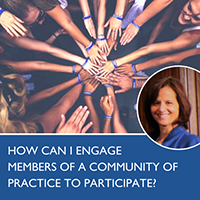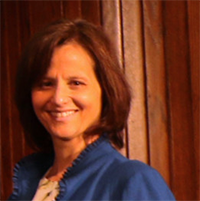How Can I Engage Members of a Community of Practice to Participate?

![]() This blog was originally posted on the USAID Learning Lab website.
This blog was originally posted on the USAID Learning Lab website.
A steady thread throughout my career has been a passion for bringing people together for relationship building and learning. One of the ways I’ve done this is to facilitate learning communities and networks (shout-out to USAID/PPL’s Reena Nadler, who I managed the CLA Community of Practice with during my time on LEARN!). Engaging members is probably the toughest part of getting a community of practice to thrive, so what has worked? Here are four tips to keep in mind.
- Keep a finger on the pulse of member needs and interests so that activities provide clear value, and then manage programming adaptively. If the learning community meets the needs of its members (read: helps them do their work or indulges their curiosity), they will find the time to participate. Start out by inviting member feedback through one-on-one conversations, a member survey, by observing what engages participants, and/or by noting what’s going on contextually in the organization (Is it time for staff transitions? What kinds of processes or under which priority themes are members focused on?). Then plan for regular ways to check back in on topics, given that needs and interests shift over time, and on the approach to facilitating the CoP. Consider a periodic pause and reflect session or a participant poll at the close of each learning activity. Then adjust programming as needed. Also keep an ear to the ground for experience among members or other experts that can benefit the learning community, and invite them to share.
- Focus on trust-building. Plan ways for members to get to know each other and establish trust. Some ideas include:
- For participants in different locations, connect via video when possible over just audio.
- Start remote activities with an icebreaker such as name/location/one question I have about today’s topic, by sharing a photo of “the view from my desk”, a single word check-in, or My favorite (fill in the blank).
- Ask members to fill out a profile with their background, interests and current work program to circulate across the community
- Take advantage of (future) opportunities already in place for all or some members to meet face-to-face
- Involve members in ways that incentivize them. For those members who respond to recognition or ways to establish or enhance their reputation, identify opportunities for them to share what they know with the community by authoring a blog, use case or success story, or by asking them to share their subject matter expertise during a knowledge exchange event. Where sense of purpose is the biggest motivator, rally participants around a shared goal. And if mastery (the desire to get better at something that matters) most piques a member’s interest, highlight the knowledge they will acquire through their participation in CoP activities. (For more on these incentives, see this article in the Knowledge Management for Development Journal.) Giving members a role in the delivery of an activity, such aS note taker or segment facilitator, is also engaging and can build their skills.
- Establish a routine for community interaction. By planning a regular live video dialogue, say, the first Wednesday or every month or proposing a topic of the month for online discussion, participants begin to cultivate the habit of exchange with their peers.
Especially now, as increasingly more activities move online, what has motivated you to participate in a community of practice? For those of you facilitating learning communities, what approaches have members responded to?

ABOUT THE AUTHOR
 Bari Rabin is most passionate about work that has people at its center—connecting stakeholders for relationship building and learning, convening, facilitating, and creating the space for voices to be heard through consultation and dialogue.
Bari Rabin is most passionate about work that has people at its center—connecting stakeholders for relationship building and learning, convening, facilitating, and creating the space for voices to be heard through consultation and dialogue.
She has been at the forefront of organizational learning in international development, from introducing Knowledge Management (KM) at the World Bank as staff of the first Latin America Region KM team, to more recently building USAID staff capacity to integrate collaborating, learning and adapting (CLA) through flagship USAID LEARN contract. She is now the CLA Lead for the USAID/Colombia Monitoring, Evaluation and Learning Contract.
Bari is passionate about Latin America with experience across regions, including Mexico, Central and South America, Laos PDR, Thailand, Republic of Georgia, Uganda, Ghana, and Ethiopia.





Excellent blog, thank you Bari. I too am passionate about communities of practice and I feel that their potential is huge but as yet unrealised, largely because of minuscule investment by funders. Indeed the time is ripe for CoPs to flourish – they have so many advantages as compared with physical events (which we still need, sure), but we need to balance this with more virtual discussion – not just webinars but asynchronous CoPs also.
On how to encourage participation, I agree with everything you say above. In addition, we at HIFA global health forums focus on the experience of the reader of messages. Every message that is processed is approved on the basis that it will be useful and relevant to at least some readers. Often this means going back to the author one-to-one for clarification or revision before posting. You can read more about our approach in the Knowledge Management for Development Journal https://www.km4djournal.org/index.php/km4dj/article/view/96
About HIFA: HIFA (Healthcare Information For All) is a global campaign and discussion forum with 20,000 members (frontline health professionals, librarians, publishers, researchers, policymakers, human rights activists, and others) in 180 countries, interacting in English, French, Portuguese and Spanish. In collaboration with the World Health Organization we work to improve the availability and use of healthcare information and we are supported by more than 400 health and development organisations worldwide.
Join here: http://www.hifa.org/joinhifa